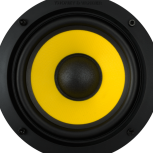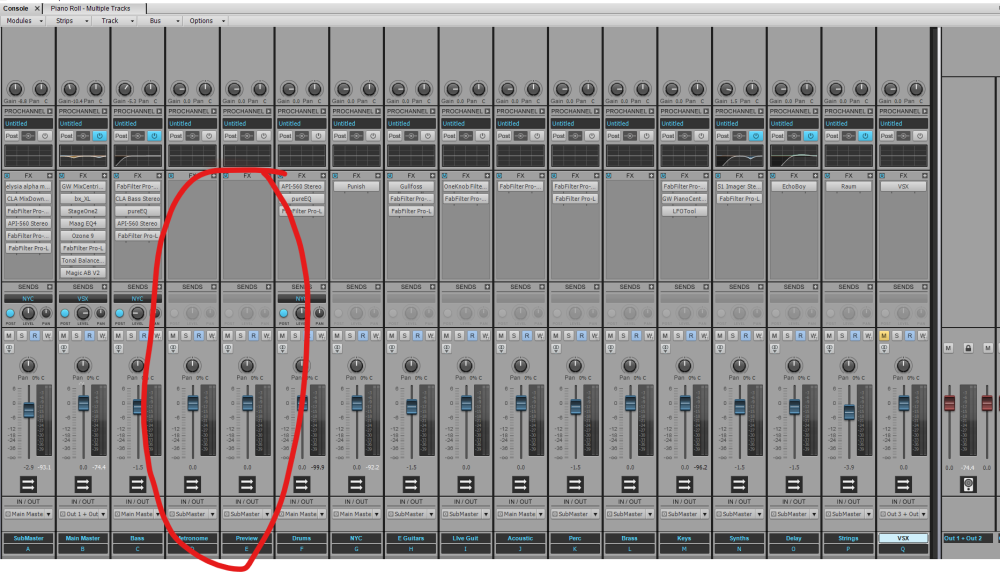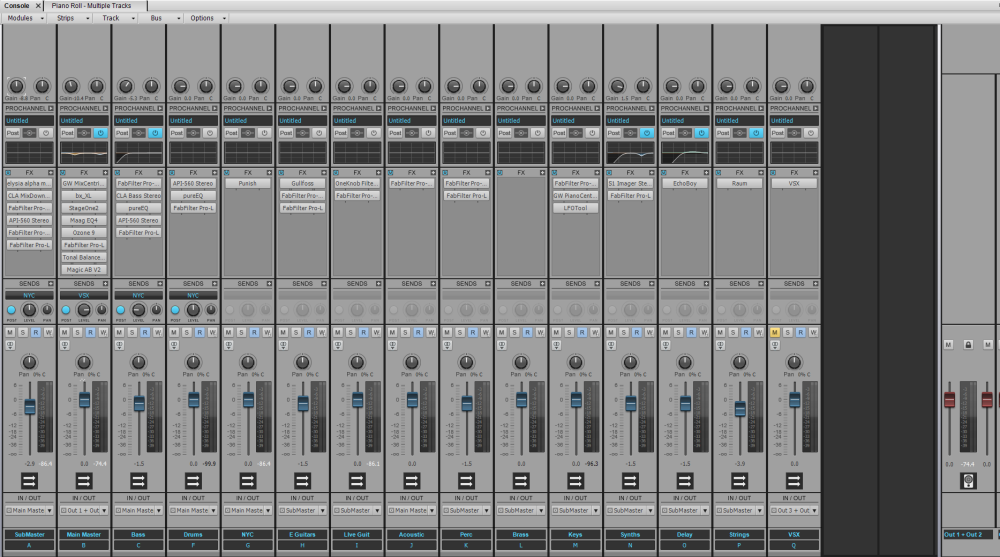-
Posts
1,294 -
Joined
-
Last visited
Everything posted by Mark Morgon-Shaw
-
Sounds like throwback kinda music, I've heard worse with BIAB but once you've heard a few they start to get very same-y Replacing the BIAB parts would go a long way to fixing this.
-
If you're making music just for yourself, you might be missing the point. Let's hear it.
-
Interesting... Universal Music Group (UMG) and BandLab Technologies, parent company of social music creation platform BandLab, have announced plans for what they call “an expansive, industry-first strategic relationship concentrated on artificial intelligence”. According to UMG, the partnership will be “centered on empowering the next generation of artists, including within BandLab’s global community”. The statement adds that “the alliance will advance the companies’ shared commitment to [the] ethical use of AI and the protection of artist and songwriter rights”. BandLab’s partnership with the world’s largest music rightsholder indicates a significant statement of intent for the Singapore-headquartered music technology firm. It also arrives at a pivotal time for the wider music industry amid the rise of AI use in music making. The company’s powerful flagship music-making app BandLab, partly built on AI-driven tech, has attracted over 60 million registered users to date. It is claimed to be “the world’s largest social music creation platform”. It also runs a tool called SongStarter that uses AI to allow users to generate musical “ideas”, including beats, melodies, and chord progressions, that can then be built upon via the main BandLab platform. Today’s news follows BandLab’s announcement of its support for the Human Artistry CampAIgn, becoming the first music creation platform to do so. BandLab Technologies also recently hired AI music expert Drew Silverstein (the Co-founder and former CEO of AI-driven music platform Amper Music) as Senior Advisor, AI, Innovation, and Strategy. Together, UMG and BandLab Technologies say that their two companies will “pioneer market-led solutions with pro-creator standards to ensure new technologies serve the creator community effectively and ethically”. Today’s news marks Universal Music Group’s latest AI-related alliance. In August, YouTube and UMG formed a partnership that they say will jointly develop AI tools that offer “safe, responsible and profitable” opportunities to music rightsholders. There are two key aspects to that partnership. First is a ‘Music AI Incubator’ at YouTube – a program by which new tools and innovations will be developed at the company in close conjunction with artists and the music biz. For now, this ‘Incubator’ is kicking off via a partnership between YouTube and UMG, incorporating feedback and guidance from UMG-signed talent. The second major element of YouTube and UMG’s announcement was that, within and beyond YouTube’s AI ‘Incubator’ project, it is publicly committing to three principles/pledges that will guide its development of music-based generative AI tools in the future. “WE ARE EXCITED TO ADD BANDLAB TECHNOLOGIES TO A GROWING LIST OF UMG PARTNERS WHOSE RESPONSIBLE AND INNOVATIVE AI WILL BENEFIT THE CREATIVE COMMUNITY.” SIR LUCIAN GRAINGE, UNIVERSAL MUSIC GROUP Commenting on the partnership with BandLab, Sir Lucian Grainge, Chairman & CEO, Universal Music Group, said: “We welcome BandLab’s commitment to an ethical approach to AI through their accessible technology, tools and platform. “We are excited to add BandLab Technologies to a growing list of UMG partners whose responsible and innovative AI will benefit the creative community.” “GIVEN BANDLAB’S PASSION FOR MUSIC AND THEIR DEDICATION TO NURTURING EARLY-STAGE ARTISTRY AT THE NEXUS OF ECOSYSTEM TRANSFORMATION, THEY ARE AN EXCELLENT PARTNER THAT IS COMPELLING FOR US ON MULTIPLE FRONTS.” MICHAEL NASH, UMG Michael Nash, EVP and Chief Digital Officer, UMG added: “Meng Kuok and his team at BandLab Technologies, as well as the Caldecott Music Group network, have achieved impressive scale at the dynamic intersection of social music and creator technology innovation. “At UMG, we constantly seek to empower and support both established and emerging artists. Given BandLab’s passion for music and their dedication to nurturing early-stage artistry at the nexus of ecosystem transformation, they are an excellent partner that is compelling for us on multiple fronts. Added Nash: “This is more important than ever right now as AI assumes an increasingly prominent place in the evolution of music creation tools. We look forward to establishing new creative, marketing, and commercial opportunities for our artists and actively engaging with BandLab’s creator community through a highly synergistic structure, collectively protecting today’s and tomorrow’s future superstars through responsible approaches to utilization of AI in the creative process.” “THROUGH OUR JOINT EFFORTS, WE ANTICIPATE A FUTURE OF MUSIC THAT IS INNOVATIVE, REWARDING, AND ENDLESSLY INSPIRING.” MENG RU KUOK, BANDLAB TECHNOLOGIES Meng Ru Kuok, CEO & Founder, Caldecott Music Group and CEO of BandLab Technologies, said: “BandLab Technologies and our wider Caldecott Music Group network is steadfast in its respect for artists’ rights and the infinite potential of AI in music creation and we believe our millions of users around the world share in this commitment and excitement. “Though new technologies offer unbelievable possibilities to break down more barriers for creators, it’s essential that artists’ and songwriters’ rights be fully respected and protected to give these future generations a chance of success. “As demonstrated by BandLab embracing the Human Artistry Campaign principles and this collaboration with UMG, we are committed to getting it right. Through our joint efforts, we anticipate a future of music that is innovative, rewarding, and endlessly inspiring.”
-
Some uses You can quickly check your project's waveforms and loudness levels. You can easily see where clipping has occurred. You can use the Stats tab to see your loudness stats. You can save time by not having to output a file which can take a while. You can easily identify any issues with the waveforms before committing to a full render. About the loudness stats Once the Dry Run process is finished, you can view the loudness statistics for your project by clicking on Stats/Chart → Open Render Statistics. This includes the integrated LUFS, true peak, and maximum peak levels, as well as the short-term and momentary loudness levels. This information is useful for ensuring that your track meets the loudness standards of streaming services like Spotify, Apple Music, and YouTube. These render statistics can be enabled, disabled, and configured in Preferences → Audio → Rendering. ▶ Here’s a full list with all terms used and their meanings. Useful actions There’s a bunch of useful actions that allow you to dry run render things like your mix, your tracks, time selection and even selected items! Open the Actions menu (shortcut: ?) and do a search for “dry run”, you’ll find: Calculate loudness of master mix via dry run render Calculate loudness of master mix within time selection via dry run render Calculate loudness of selected items via dry run render Calculate loudness of selected items, including take and track FX and settings, via dry run render Calculate loudness of selected tracks via dry run render Calculate loudness of selected tracks within time selection via dry run render Calculate mono loudness of selected tracks via dry run render Calculate mono loudness of selected tracks within time selection via dry run render
-
True, Misha, but in the world of production music, having a taste that resonates with an audience isn't just a preference; it's a prerequisite. Whilst your passion for BIAB is admirable I can't help but wonder why I've never heard any of your music.
-

Plug-in Manager Scan Window Shrinks Midway
Mark Morgon-Shaw replied to sjoens's topic in Feedback Loop
Are you sure you're not just moving further away ? -
What could be cooler is a new breed of ' Skip Marker ' that when reached wil jump to the next marker. It could just be an added option on the existing markers
-

Multiple Multidock Instances Request
Mark Morgon-Shaw replied to SloHand Solo's topic in Feedback Loop
Yes I suggested something similar about 4yrs ago -
An informed one. I hear tracks from people that use it all the time. Dreadful.
-

What the F*** do People Do With the Power Supplies???!!!!
Mark Morgon-Shaw replied to Byron Dickens's topic in Gear
Me too Then I still can't find the one I want and have to buy a new one -
Great. Do I take it the next release is new Sonar and not CbB ?
-
Still annoying though especially if you have a lot of busses. I've started a new project tonight and can confirm they won't stay hidden. This has not happened in previous versions AFAIK as I've always had them hidden. Now I can't permanantly hide them, they just re-appear when the project is re-loaded Annoying
-
You could get a much better result from Ezdrummer, EzKeys & EzBass
-
I use it a lot and I've noticed no difference in that respect here.
-
Because I rarely use them and they waste space in the console buss view ...so it ends up like this Instead of this
-
Thanks - I never use Workspaces normally but this is a re-working of an older project where I did use a Workspace. However having set it to None, hiding the Preview & Metronome buss , re-saving it and opening it again... they have re-appeared
-
Has anyone else noticed this issue - When working on a project I hide the Metronome and Preview busses but on loading the project again they re-appear as unhidden. Never had this issue before.
-
Is there a Discord for New Sonar yet ?
-
I agree it's certainly special 😆
-
You either need a better string library with more articulations or need to fake it somehow . There are some libraries that have fast attack patches which might help but a lot of folks fake the accented feel by doubling the start of the note with a pizzi articulation and mixing it in such a way that it sounds like one bowing action. Also boucing the track to audio might make it easier to control the note envelope using automation
-

DAWproject file exchange standard
Mark Morgon-Shaw replied to Starship Krupa's topic in Feedback Loop
That methodology has always struck me as a bit of a strange way of going about things. Surely more efficient to learn onw DAW really well and just roll with it ? -
Gave Next a try ( I have Discord here on my studio PC btw for a few years as we use it to talk about collabs and hadn't noticed any issues ) Next seems very slick and polished, it's too simplistic for me to use in any real way but I am guessing I am not arget audience and I can see the appeal to those stepping up from something like the Bandlab App or creators seeking a first DAW. I like the visual style, and the one thing it has that I wish CbB or Sonar had is the Xsampler - I like the way if you just drag a loop into the track pane it offers to make it into a sampler instrument. I hope they carry this over to the new Sonar.
-

DAWproject file exchange standard
Mark Morgon-Shaw replied to Starship Krupa's topic in Feedback Loop
I have to collaborate with mutlple musicians for some of my production music tracks and everyone I know in the industry just sends each other Wav files as it's so much simpler. One guy I work with regularly has CbB and honestly I don't even want his project files because how he works and lays everything out is very diffrent to how I work. His projects look like a unicorn vomited on the screen whereas mine are very simple and grey. I use folders, he does not. I use multiple busses - he does not. Even the way people name their tracks differs. So it's not really an issue to bounce a bunch of track-outs and everyone who does it regular enough knows the drill. Print any FX that are an integral part of the sound and leave the rest to the person doing the final mix/master. Most of us use Dropbox to send wav files to each other. I think that's as univeral as it gets. -
I first tried it in the late 90s when as you say it was purely midi , wasn't impressed then ( I ended up buying a Yamaha TG300 and programming my own tracks instead ) nor in 2000's when I demo'd it again nor more recently after they introduced RealTracks and there was quite an in depth review in SOS magazine. I think if you're into a certain chintzy kinda trad style or just want a tool that will let you easily demo a song to be replaced with better parts then it has a role to play but some of the more modern styles are laughable once it goes outside it's lane. Just had a watch on Youtube, the actual instrument sounds on these things have not improved that much in the last 15-20 years, they're not as good as what you can do in a decent plugin which may even be free. Again the style are kinda chintzy throwback trad stuff which is fine - I didn't spot anything vaguely contemporary but I suspect given the sounds are not that brilliant it would be another cheese-fest. Something like VPS Avenger will sound way better, Cool but that's not what you originally said. As an extension of a Chord Track feature it should automtically reharmonize the underlying midi ( and audio) to follow anyway. That's how it works in StudioOne for example. But it's nothing like a QY100 etc.









